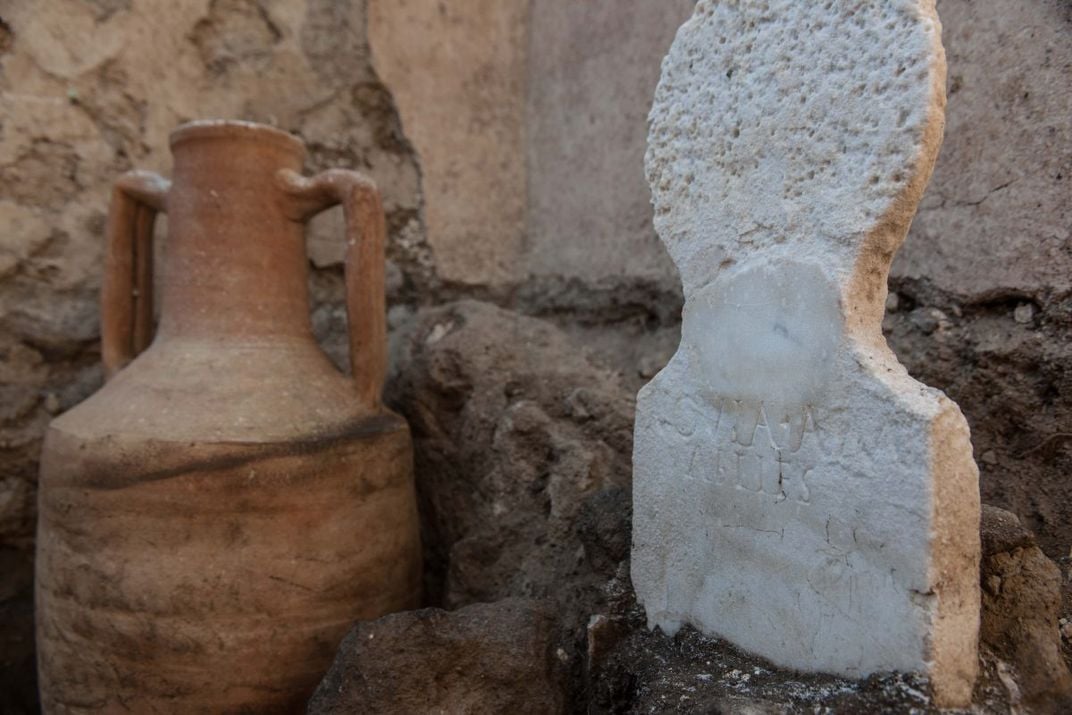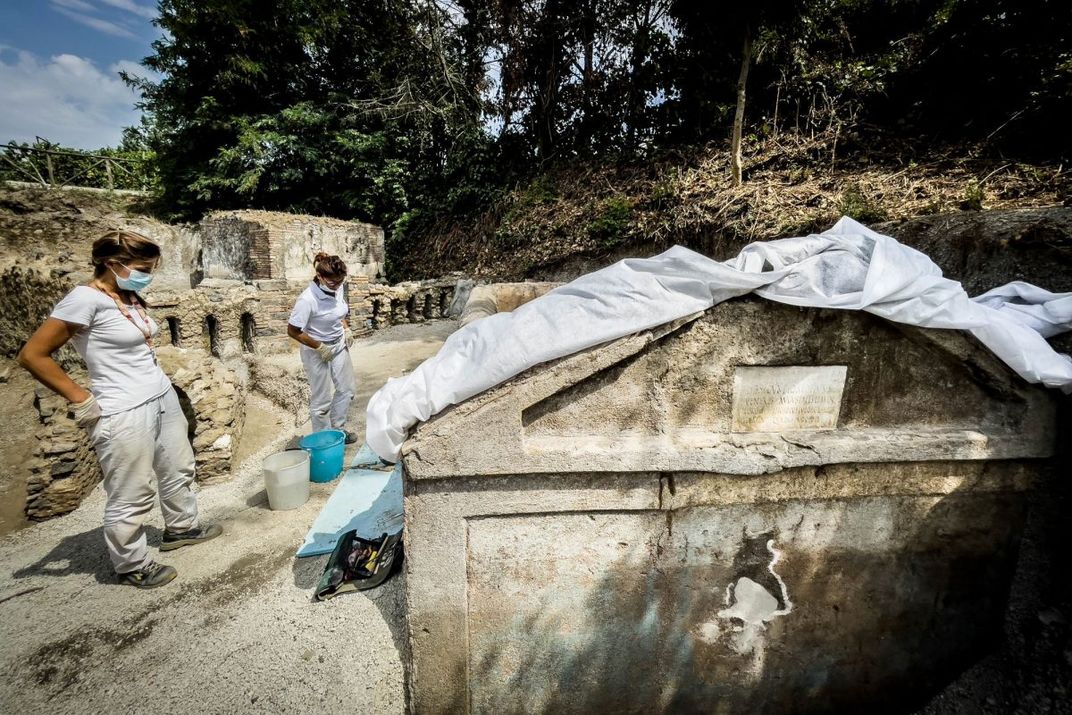Roman Priest’s Exceptionally Well-Preserved Remains Found in Pompeii
Marcus Venerius Secundio died in his 60s decades before Mount Vesuvius’ eruption in 79 C.E.
:focal(2361x1597:2362x1598)/https://tf-cmsv2-smithsonianmag-media.s3.amazonaws.com/filer/97/94/979491e6-83bb-4cfd-b53a-9dd20d9134a4/scheletro_porta_sarno___2.jpg)
Researchers have unearthed one of the most well-preserved sets of human remains ever found in Pompeii, the ill-fated Roman city razed by a volcanic eruption in 79 C.E.
As Silvia Lambertucci reports for Agenzia Nazionale Stampa Associata (ANSA), the skeleton, which still has hair and a partially visible ear, belonged to a man who died in his 60s in the decades leading up to Pompeii’s destruction.
Per a statement from the Archaeological Park of Pompeii, experts discovered the remains at the necropolis of Porta Sarno, just east of the ancient city center. An inscription on the man’s tomb identifies him as Marcus Venerius Secundio, a formerly enslaved individual who later became a priest.
“Pompeii never ceases to amaze,” says Dario Franceschini, Italy’s culture minister, in the statement.
The skeleton shows signs of partial mummification, suggesting Secundio may have been embalmed before his burial, reports Reuters’ Crispian Balmer. Ancient Romans used certain textiles to preserve corpses, and scholars found scraps of what appear to be fabric in the tomb.
According to ANSA, the find is unique because the Romans typically cremated adults’ remains, reserving burials for young children and infants. Two funerary urns, one of which was labeled Novia Amabilis, or “kind wife,” were found in Secundio’s tomb, notes Stephanie Pappas for Live Science.
Secundio served as the custodian of Pompeii’s Temple of Venus upon gaining his freedom from slavery. Inscriptions on his tomb indicate that he led ludi, or theater performances, in both Latin and Greek, offering researchers confirmation that the languages were used alongside each other in Pompeii.
“That performances in Greek were organized is evidence of the lively and open cultural climate which characterized ancient Pompeii,” says Gabriel Zuchtriegel, director of the archaeological park, in the statement, per a translation by the Associated Press (AP).
The monumental scale of Secundio’s tomb suggests he’d attained social and economic status by the time of his death.
“He didn’t become super rich, but certainly he reached a considerable level of wealth,” Zuchtriegel tells the AP.
Porta Sarno is currently closed to the public, but officials hope to open the necropolis to visitors in the future.
Mount Vesuvius’ pyroclastic flows and poisonous fumes killed around 2,000 people in Pompeii and the neighboring city of Herculaneum. Inadvertently preserved by the volcano’s ash and pumice, the city’s ruins have fascinated researchers for hundreds of years, with the first systematic excavations of the site taking place in the mid-18th century.
Since 2012, the Great Pompeii Project, an ongoing conservation initiative funded largely by the European Union, has unearthed a stunning array of treasures in the ancient city, from a snack bar that served snails and fish to a sorceress’ kit. To date, experts have exhumed about two-thirds of the 165-acre settlement.
The fact that Secundio was buried rather than cremated contradicts the long-held idea that Roman funeral rites were followed strictly for fear of incurring the wrath of the gods. If he chose this manner of burial himself, that “could mean … there was a certain ideological freedom [in Pompeii],” Llorenç Alapont, an archaeologist at Universidad Europea de Valencia who participated in the excavation, tells ANSA, per Google Translate.
He adds, “[I]t is extraordinary.”
/https://tf-cmsv2-smithsonianmag-media.s3.amazonaws.com/accounts/headshot/Isis_Davis-Marks_thumbnail.png)
/https://tf-cmsv2-smithsonianmag-media.s3.amazonaws.com/filer/23/6c/236c6c48-8374-4fd0-9c06-7764278f5474/dettaglio_capelli_scheletro_porta_sarno.jpg)
/https://tf-cmsv2-smithsonianmag-media.s3.amazonaws.com/filer/d6/64/d6641cff-a05c-4adc-9795-1b2ea4cbebd9/scheletro_porta_sarno___1.jpg)

/https://tf-cmsv2-smithsonianmag-media.s3.amazonaws.com/filer/e5/fe/e5fe844e-a09c-480b-98ef-46ab1d97ae16/foto-tomba-porta-sarno-cesare-abbate-4-1200x800.jpeg)

/https://tf-cmsv2-smithsonianmag-media.s3.amazonaws.com/accounts/headshot/Isis_Davis-Marks_thumbnail.png)